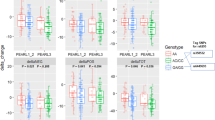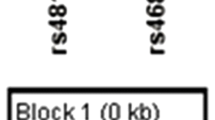Abstract
The relationship between TaqI A dopamine D2 receptor (DRD 2) polymorphism and therapeutic response to bromperidol, a selective dopamine antagonist, was investigated in 30 acutely exacerbated schizophrenic inpatients. Patients were treated with bromperidol 6–18 mg/day for 3 weeks. Clinical symptoms were evaluated by the Brief Psychiatric Rating Scale (BPRS) before and 3 weeks after the treatment. The TaqI A genotypes were determined with the PCR method. There was no significant difference in the percentage improvement of total BPRS or 5-subgrouped symptoms (positive, negative, anxiety-depression, excitement and cognitive symptoms) after the 3-week treatment between the patients with A1 alleles (n=18) and those with no A1 allele (n=12). Although the present study is preliminary, it is suggested that the TaqI A DRD 2 polymorphism is not associated with therapeutic response to bromperidol in schizophrenic patients.
Similar content being viewed by others
Author information
Authors and Affiliations
Additional information
Received: 27 September 2000 / Accepted: 10 January 2001
Rights and permissions
About this article
Cite this article
Suzuki, A., Kondo, T., Mihara, K. et al. Association between TaqI A dopamine D2 receptor polymorphism and therapeutic response to bromperidol: a preliminary report. European Archives of Psychiatry and Clinical Neurosciences 251, 57–59 (2001). https://doi.org/10.1007/s004060170053
Issue Date:
DOI: https://doi.org/10.1007/s004060170053




